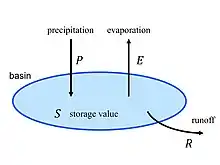Water balance
In hydrology, a water balance equation can be used to describe the flow of water in and out of a system. A system can be one of several hydrological domains, such as a column of soil or a drainage basin. Water balance can also refer to the ways in which an organism maintains water in dry or hot conditions. It is often discussed in reference to plants or arthropods, which have a variety of water retention mechanisms, including a lipid waxy coating that has limited permeability.
Equation

A general water balance equation is:[1]
where
- is precipitation
- is evapotranspiration
- is streamflow
- is the change in storage (in soil or the bedrock / ground water)
This equation uses the principles of conservation of mass in a closed system, whereby any water entering a system (via precipitation), must be transferred into either evaporation, surface runoff (eventually reaching the channel and leaving in the form of river discharge), or stored in the ground. This equation requires the system to be closed, and where it isn't (for example when surface runoff contributes to a different basin), this must be taken into account.
Extensive water balances are discussed in agricultural hydrology.
A water balance can be used to help manage water supply and predict where there may be water shortages. It is also used in irrigation, runoff assessment (e.g. through the RainOff model [2]), flood control and pollution control. Further it is used in the design of subsurface drainage systems which may be horizontal (i.e. using pipes, tile drains or ditches) or vertical (drainage by wells).[3] To estimate the drainage requirement, the use of a hydrogeological water balance and a groundwater model (e.g. SahysMod [4]) may be instrumental.
The water balance can be illustrated using a water balance graph which plots levels of precipitation and evapotranspiration often on a monthly scale.
Several monthly water balance models had been developed for several conditions and purposes. Monthly water balance models had been studied since the 1940s.[5]
Models
Several diagnostic measures in hydrology can be used to select and evaluate the performance of water balance models.
Applications
- Evaluate the components of the hydrologic cycle
- Snowmelt simulation
- Climate change impact assessment
- Flow forecasting and project design
- Assess agricultural water management
Types
- Models using precipitation (rainfall) as input
- Models using rainfall and temperature as input
- Models using rainfall and potential evaporation as input
- Models using daily input data
References
- http://www.alevelgeography.com/water-balance/
- "RainOff, surface runoff model". Retrieved 2010-07-28.
- "Free articles and software on drainage of waterlogged land under irrigation". Retrieved 2010-07-28.
- "Sahysmod groundwater model". Retrieved 2010-07-28.
- Xu, C.-Y.; V.P. Singh (1998). "A Review on Monthly Water Balance Models for Water Resources Investigations". Water Resources Management. 12 (1): 31–50. doi:10.1023/A:1007916816469. S2CID 153801907.
External links
- R.J. Oosterbaan. "DRAINAGE AND HYDROLOGY/SALINITY" (PDF). www.waterlog.info. Retrieved 2016-05-20.
